Book contents
Part II - Operational Issues
Published online by Cambridge University Press: 05 April 2016
- Type
- Chapter
- Information
- Koenig and Schultz's Disaster MedicineComprehensive Principles and Practices, pp. 163 - 462Publisher: Cambridge University PressPrint publication year: 2016



